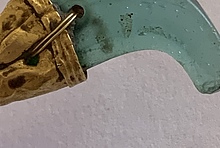Home PageAbout MindatThe Mindat ManualHistory of MindatCopyright StatusWho We AreContact UsAdvertise on Mindat
Donate to MindatCorporate SponsorshipSponsor a PageSponsored PagesMindat AdvertisersAdvertise on Mindat
Learning CenterWhat is a mineral?The most common minerals on earthInformation for EducatorsMindat ArticlesThe ElementsThe Rock H. Currier Digital LibraryGeologic Time
Minerals by PropertiesMinerals by ChemistryAdvanced Locality SearchRandom MineralRandom LocalitySearch by minIDLocalities Near MeSearch ArticlesSearch GlossaryMore Search Options
The Mindat ManualAdd a New PhotoRate PhotosLocality Edit ReportCoordinate Completion ReportAdd Glossary Item
Mining CompaniesStatisticsUsersMineral MuseumsClubs & OrganizationsMineral Shows & EventsThe Mindat DirectoryDevice SettingsThe Mineral Quiz
Photo SearchPhoto GalleriesSearch by ColorNew Photos TodayNew Photos YesterdayMembers' Photo GalleriesPast Photo of the Day GalleryPhotography
╳Discussions
💬 Home🔎 Search📅 LatestGroups
EducationOpen discussion area.Fakes & FraudsOpen discussion area.Field CollectingOpen discussion area.FossilsOpen discussion area.Gems and GemologyOpen discussion area.GeneralOpen discussion area.How to ContributeOpen discussion area.Identity HelpOpen discussion area.Improving Mindat.orgOpen discussion area.LocalitiesOpen discussion area.Lost and Stolen SpecimensOpen discussion area.MarketplaceOpen discussion area.MeteoritesOpen discussion area.Mindat ProductsOpen discussion area.Mineral ExchangesOpen discussion area.Mineral PhotographyOpen discussion area.Mineral ShowsOpen discussion area.Mineralogical ClassificationOpen discussion area.Mineralogy CourseOpen discussion area.MineralsOpen discussion area.Minerals and MuseumsOpen discussion area.PhotosOpen discussion area.Techniques for CollectorsOpen discussion area.The Rock H. Currier Digital LibraryOpen discussion area.UV MineralsOpen discussion area.Recent Images in Discussions
GeneralPyrite Disease (Rot)

25th Apr 2006 14:41 UTCAnonymous User
Cheers,
Ian

25th Apr 2006 16:23 UTCBarry Flannery Expert
The common iron sulphide minerals marcasite, pyrrhotite and pyrite are all rather unstable and tend to oxidise when exposed to the atmosphere. They turn into ferrous sulphate then ferric sulphate and sulphuric acid. The acid accelerates the reaction, so it becomes autocatalytic, with the result that once it gets started it speeds up and there's no stopping it. As the reaction products have a larger volume than the starting material the whole specimen just disintegrates and ends up as a handful of crumbs. Meanwhile the acid generated eats through everything around it.
Instead it is a function of surface area and humidity. The larger the surface area, the more reactive the sample. Thus, the framboidal/granular pyrites that are so typical of the big zinc mines, are very unstable. They are composed of many fine grains, and have pores or fissures penetrating deep inside them, so they have a large reactive area available. They also tend to contain some marcasite, which only worsens things. Big chunky xls, like the cubes in matrix from Spain, have a very low surface area to volume ratio, and so last indefinitely.
I have tried soaking in water to remove the acid and ferrous sulphate, then in dilute potassium hydroxide solution to make it alkaline. This seems to slow it down, but still they fall apart eventually. There is a complex and expensive vacuum impregnation method that is employed in museums to try and save pyritised fossils, but its success rate is variable. Sealing them with epoxy does not work either - they actually explode after a while as the pressure builds up!
Avoid fine grained, granular pyrite. Store your specimens in as dry a place as possible. Dryness is the key to success.
Regards,
Barry

25th Apr 2006 16:39 UTCBarry Flannery Expert
In regard to identifying the disease, simply a fowl smell and ''crumbliness'' of the specimenw will tell.
Also, I strongly suggest you put your specimen into an alkaline solution until it stops fizzing (you'd be surprised!).
Regards,
Barry

26th Apr 2006 01:49 UTCChester S. Lemanski, Jr.

27th Apr 2006 13:39 UTCAlfredo Petrov Manager

27th Apr 2006 14:35 UTCPhil B.
Thanks, Phil.

27th Apr 2006 15:32 UTCAlfredo Petrov Manager




Mindat.org is an outreach project of the Hudson Institute of Mineralogy, a 501(c)(3) not-for-profit organization.
Copyright © mindat.org and the Hudson Institute of Mineralogy 1993-2024, except where stated. Most political location boundaries are © OpenStreetMap contributors. Mindat.org relies on the contributions of thousands of members and supporters. Founded in 2000 by Jolyon Ralph.
Privacy Policy - Terms & Conditions - Contact Us / DMCA issues - Report a bug/vulnerability Current server date and time: May 14, 2024 08:52:58
Copyright © mindat.org and the Hudson Institute of Mineralogy 1993-2024, except where stated. Most political location boundaries are © OpenStreetMap contributors. Mindat.org relies on the contributions of thousands of members and supporters. Founded in 2000 by Jolyon Ralph.
Privacy Policy - Terms & Conditions - Contact Us / DMCA issues - Report a bug/vulnerability Current server date and time: May 14, 2024 08:52:58











